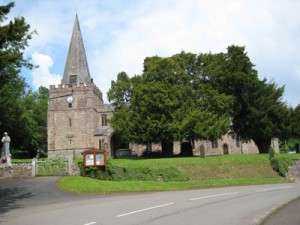This church is 13th Century.
There have been later additions to the building, and it is very large for the size of the village.
In 1867 the church was re-opened in the presence of the Right Hon. and Ven. the Lord Saye and Sale, Archdeacon of Hereford.
The old church, having long been known for its large proportions of the nave, was also known for the “tasteless and comfortless aspect of the interior”.
St. Mary’s Church undergoes Restoration
This pretty, but neglected little Norman church had been marred over the centuries with unsuitable additions and alterations; the nave was thoroughly restored, stained and vanrnished and the pillars and arches of the arcade were stripped of whitewash. The shingled spire was dilapidated, so new shingles were provided. The burial ground was enlarged, drained and fenced. Next, the roofs of the chancel, North Transept and aisles and nave were stripped of plaster and exposed to view. Everything was thoroughly cleaned of whitewash and plaster and carefully pointed with grey mortar. Many more aesthetic works were carried out and the interior was greatly improved and enhanced, with the beautifully carved chancel stalls and Priests’ desks showing the splendid work of Mrssrs Niblett & King of Gloucester, who also made the English oak Altar.
The heating was by hot air flues, devised by Richard Lloyd of Welshpool, which proved to be economical and very effective.
New Pulpit for St. Mary’s Church
The magnificent pulpit was by Mr. Forsyth and was carved from Painswick Stone; it sports eight panels, four of which contain the signs of the four Evangelists, and the other four show the emblems of the crucifixion – the cross and thorns; the seamless coat; the scourge, ladder and spear, and the nails.
New Font for St. Mary’s Church
The font is from the same source as the pulpit, and the cover is in beautiful wrought iron, octaganol in shape. It rises nearly five feet, being elevated and lowered by tackle suspended from the roof. The font cover was given in 1867 by Margaret Morris Bray.
An ancient early English font was found buried upside down under the present 15th century font, and this is on display in the church.
All in all, and there were many more wonderful aspects to this restoration, this little church was restored in the most glorious manner.
